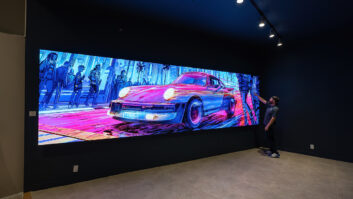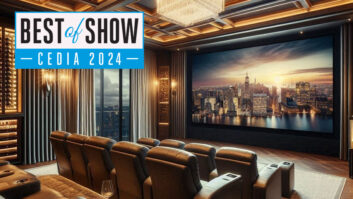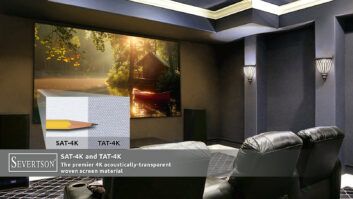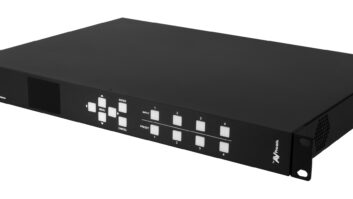
The Smart Home as it currently exists can be thanked for many of the innovations we have seen in the custom integration channel. In addition to the simplification of the control and automation process, which now more easily pulls security and lighting control into the mix, the ability to stream audio and video has also been kicked up a notch. In the case of video, the much wider acceptance of 4K as the viewing standard, more robust equipment, and higher residential bandwidth—as well as wider availability of content—have reinvigorated the complex configuration and integration of video distribution in homes.
“The most dramatic impact can be tied to Apple’s introduction of a 4K-capable Apple TV, making content widely available at an affordable price,” said Jay Bakalar, president of Metro Eighteen, an integration company based in San Francisco. “Add 4K TVs that cost a small fraction of what they were just a few years ago, and the only remaining challenge is to deliver the content reliably to all of the end-points throughout the home. Now that issues surrounding the source, home networks, and standards have been adequately resolved, Metro Eighteen relies on the Savant video-over-IP solution exclusively.”
While video distribution has long been in custom integrators’ wheelhouse, the ability to deliver video over IP is taking flight. It helps that consumers are now fully aware of 4K, which has been aided by manufacturers, both popular and niche, promoting it and integrating it as a standard feature of their products and services. Todd Anthony Puma, owner The Source Home Theater in New York, also noted that, along with consumer awareness, the ability to send 4K60 4:4:4 content over a standard gigabit network has opened up the residential retrofit market where wiring infrastructures are a limitation, therefore creating a faster inroad into the residential market.
“As always, end users favor convenience, quality, and reliability,” Puma said. “Many end users require education on the integrator’s part as to what is available to them. We have not seen so much in terms of specific requests or features, but more a curiosity as to what is available. This is in no large part being prompted by the push by GAFA (Google, Apple, Facebook, Amazon) and their voice control entries into the market. This increased awareness is driving end users to ask more of the ‘Well, what else can we do?’ questions.”
Defining a distributed video system as a personalized system, Puma added that eliminating multiple set-top boxes and giving clients “his, hers, and theirs” content options provides integrators the opportunity to pitch video over IP without having to change out wiring infrastructures, as well as to offer software solutions that will be prevalent over time. This “network as the system,” he noted, makes sense to many end users who now depend on their home network for all their technology needs.
The real sticking point is expenditure. Video distribution systems are inherently expensive due in large part to the equipment costs, but with video over IP, the ability to scale systems over a network facilitates easier upgrades and remote management. And, with home networks moving from 1G to 10G, as well as the rollout of fiber optic networking, video distribution systems can focus on cleanly and quickly delivering content relatively free of delays, artifacts, and glitches.

“We are offering this as the future of distributed audio and video,” said Eli Weinkle, CEO of NXT AV, based in Irvine, CA. “With the adoption of 4K, this is the only real option to fully take advantage of the 18Gbps standard. Pitching video distribution utilizing 10G switches really catches a lot of clients’ interests, as they do not expect 10G networks to be utilized in residential applications. That, along with the idea that they can scale their system at any time as long as there is still a free port on the switch, just blows their mind. It’s a real game changer.”
Product Integration
Integrators are taking advantage of new and legacy equipment to deliver today’s video distribution systems. Bakalar, a Savant dealer for eight years, utilizes that company’s 4K video-over-IP switching platform, which is said to deliver 4K60 4:4:4 HDR video distribution over IP with zero-frame latency along with HDBaseT extenders from TechLogix.
“Also, because of our background and expertise in networking, we have been running fiber optic cables along with Cat-6a in every job for roughly a year now, giving us the flexibility to drive 4K content to any TV,” Bakalar said.
Each of Metro Eighteen’s projects features centralized video distribution based around Savant’s video-over-IP technology, with a focus on only selling premium solutions in spite of size. Bakalar’s colleague, Matt Lavin, GM at Metro Eighteen added: “I think it is vital to point out that now more than ever before, integrators really need to be experts in networking and using fiber to maximize their potential with each client and to stay current with evolving technologies. Without these critical skills, integrators will likely find it difficult to remain competitive.”
Weinkle, who is also a Savant dealer, still offers traditional video switches and HDBaseT solutions as well as card-based chassis to support existing installations, but like Bakalar, his team members at NXT AV are deploying fiber on all new projects to support any new future standards. NXT AV made a splash at last year’s CEDIA conference with a customized 100-foot yacht display behind the convention center. Armed with a client checklist that had a seamless experience within the vessel as top priority, NXT AV had to focus on delivering 16 zones of audio and 12 zones of video along with audio processing so that any HDMI source could be fed to any audio zone. The captain, too, had a request: the ability to feed video from the ship’s systems back into the switch so navigation or chart data could be retrieved on any source.
“Due to the harsh environments on the yacht, we had to isolate power via a combination of power filtration, protection, and UPSs, as well as run all video sources over shielded cable,” Weinkle explained. “Furthermore, due to limited access to the yacht while in use, we needed to make sure we could service and support the system remotely utilizing a combination of remote management and monitoring tools, IP PDUs, and managed networks. AV was handled by a Savant SmartMediaPro chassis populated with a mix of 4K service cards and 1080p cards with DSP, so we can down-mix surround sources. Real estate was also a major consideration, so the fact that we could handle all switching in a single chassis was a huge bonus. This included the ability to eliminate the need for AVRs, as we could handle surround sound decoding with an audio processing module.
“To future-proof the install, we deployed an extensive fiber infrastructure as well,” Weinkle said. “Fiber is ideal in a ship’s environment since it is not susceptible to any interference.”
The Source Home Theater focuses on use-case scenarios, taking into account the client’s current living situation, the wiring infrastructure, budget, and space requirements/restrictions. An existing client that The Source has served for more than 25 years recently had enjoyed the fourth upgrade to their high-performance media room, which at the time was fitted with a large-format 1080p DLP projector and what Puma noted as a sizable analog distributed audio/video-over-Cat-5 system running 1080i and 720p content. The client was looking to upgrade to 4K and, specifically, HDR10-compatible 4K for the entire house, along with the performance media room.
“To meet the client’s requirements, the projector was replaced with a cinema-grade 4K laser projector with HDR10 compatibility,” Puma said. The 1080p plasma TVs throughout the residence were replaced with 4K OLED and 4K LED displays, and the analog video distribution system was replaced with a video-over-IP distribution system with full HDR10 compatibility. 4K HDR10 sources were installed, including UHD Blu-ray players, 4K streaming set-top boxes, and a 4K video server to complement the existing 1080p sources.

In the media room, The Source team integrated a Dolby Atmos audio processor, and a full 18Gb-compatible video processor replaced the legacy 1080p and digital 7.1 system. Full 18Gb 4K signals were routed to the video processor before the signal was buffered and then passed onto the distributed video 4K transmitters. Additionally, the entire network hardware infrastructure was upgraded to better handle the demands of the new video IP distribution system. And finally, the automation system was also upgraded and a new user interface was developed to provide elegant, reliable control of this sophisticated upgrade.
Integration firm The Thoughtful Home, which has locations in Texas and Missouri, often turns to a variety of custom integration-grade manufacturers for its video distribution equipment, including Vanco’s HDBaseT switchers and extenders, Just Add Power’s video-over-IP solutions, and Crestron’s DigitalMedia platform and its new DM-NVX350 4K60 4:4:4 HDR Network AV Encoder/Decoder.
“Video distribution is used about 90 percent of the time on our residential installs,” said Joe Whitaker, owner of The Thoughtful Home. “Recently, a particular customer’s budget almost made us roll the entire project locally. We ended up splitting the system and using one of Vanco’s 4×4 quick install HDBaseT switches to save the day. It met our budget needs while giving us the functionality the customer wanted. Another example is a large estate we recently worked on that had major issues with formats, an odd mix of inputs and outputs, and distances. The only way to solve this issue was with AVoIP and we were able to get the job done.”
Utah-based Real Audio-Video is all about Control4 video matrix switches and Crestron DM digital media systems, according to Shawn Sorensen. With video as part of the team’s day-to-day installations, these solutions combined with the controllers makes for a complete system that the team said is reliable and easy to use.

“We often do cleanup jobs, where multiple installers have been through and the system is just not working as it should be,” Sorensen said. “In these situations, our clients are often surprised that we are able to get them up and running with a system that is easy for them to use. Our job is to ensure our clients have a system that is stable, reliable, and out of sight.”
Further Simplifications
With video over IP transforming how CIs approach their video distribution projects, there are still more features that can be added and further simplifications that can elevate the video distribution experience for both the integrator and his or her client.
Our seven integrators pointed to a number of tweaks manufacturers can implement to help make their hardware easier to install, including reducing configuration complexity, syncing product design to make rack integration and overall cable management cleaner, and the development of channel-focused 10G network gear to help support the move to AVoIP while maintaining margins they are used to.
“Having an internal method to leverage CEC would be helpful,” Whitaker noted. “Speaking more from a systematic point of view, the extraction of analog audio and video mixing needs to be implemented across the board and improved. It would be great to have variable volume on an analog output on both the transmitter and receiver to create a virtual audio matrix. This would allow the stereo audio to be usable directly into a quality amplifier, to give you that real AV matrix feel. Another product feature that is currently unavailable is an HDMI pass-through for a transmitter device that would provide every HDMI input with a direct non-matrix output pass-through. This feature would allow for the addition of a video wall and tiling without the need for source splitters, etc., and would have huge implications for centralized distribution.”
Rich Fregosa, owner of R.A. Fregosa Electronic Interiors, added the need for better training and tools for dealers to achieve high-quality end results, with current technology demands ranging from copy protection requirements to increased video resolutions requiring dealers to not only commission a system but to also be able to properly calibrate it and keep connectivity discrepancies to a minimum.
“HDCP, EDID, chroma bit depth, and color subsampling are foreign and intimidating terms for many integrators and manufacturers need to focus on giving tools to their dealers to better optimize their systems and understand the ‘why’ of the product,” he added.
As video distribution continues its evolution in the residential space, integrators anticipate even more unification between the smart home ecosystem and the home entertainment branch—what Bakalar and Lavin refer to as the “big pipe,” which would supply all data—and that all network appliances in the home such as TVs and video-over-IP hardware will simply be plug-and-play with costs to decrease as wider adoption takes hold.
“The next evolutionary step for video distribution will be fiber or wireless,” Whitaker predicted. “People say the tech is not there, but video service providers do it all the time. Then the next big step will be dropping copper and opening up the bandwidth gates! The wider acceptance of video over IP will come with a reduction in cost. I expect AVoIP costs will decrease organically to be more in line with HDBaseT. And, as the technology becomes more attainable, those that are less network savvy will embrace the category.”







